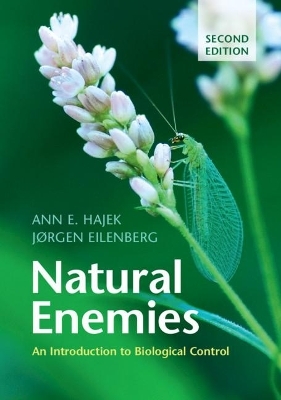
Natural Enemies
Cambridge University Press (Verlag)
978-1-107-66824-9 (ISBN)
This second edition of Natural Enemies will give students, professionals, and anyone wishing to learn the basics of biological control a fully updated and thorough introduction. The book discusses the huge diversity of organisms used in the control of pests, weeds and plant pathogens, and compares the many different strategies referred to as 'biological control': the introduction of exotic natural enemies, application of predators, parasitoids, and microorganisms as biopesticides, and manipulation of the environment to enhance natural enemy populations. The authors present the ecological concepts which form the bases of biological control and discuss recent changes to make biological control safe for the environment. Case studies are included throughout, providing in-depth examples of the use of different organisms and strategies in a variety of ecosystems. A new chapter covers the current challenges; the impact of climate change, the problem of invasive species, and how biological control can aid sustainability.
Ann E. Hajek is a Professor in the Department of Entomology at Cornell University, New York. Her career has focused on biological control, with research ranging from developing biopesticides to investigating why epizootics of insect diseases occur. The International Organization for Biological Control, Nearctic Regional Section, presented her with their Distinguished Scientist Award in 2011. Jørgen Eilenberg is a Professor in the Department of Plant and Environmental Sciences at the University of Copenhagen, where he leads a research team studying insect pathogens and biological control. He was President of the Society for Invertebrate Pathology 2012–2014.
Preface; Acknowledgements; Part I. Introduction: 1. Why use natural enemies?; 2. Introduction to biological control; Part II. Strategies for Using Natural Enemies: 3. Classical biological control; 4. Augmentation: inundative and inoculative biological control; 5. Conservation and enhancement of natural enemies; Part III. Biological Control of Invertebrate and Vertebrate Pests: 6. Ecological basis for use of predators, parasitoids, and pathogens to control pests; 7. Predators; 8. Insect parasitoids: attack by aliens; 9. Parasitic nematodes; Part IV. Microbial Pathogens of Invertebrates and Vertebrates: 10. Bacterial pathogens of invertebrates; 11. Viral pathogens of invertebrates and vertebrates; 12. Fungal pathogens of invertebrates; Part V. Biological Control of Weeds: 13. Biology and ecology of herbivores used for biological control of weeds; 14. Phytophagous invertebrates and vertebrates; 15. Plant pathogens for controlling weeds; Part VI. Biological Control of Plant Pathogens and Plant Parasitic Nematodes: 16. Biology and ecology of microorganisms for control of plant diseases; 17. Microbial antagonists combating plant pathogens and plant parasitic nematodes; Part VII. Biological Control: Concerns, Changes and Challenges: 18. Making biological control safe; 19. Biological control as part of integrated pest management; 20. Our changing world: moving forward; Glossary; References; Index.
| Erscheinungsdatum | 19.09.2018 |
|---|---|
| Zusatzinfo | 25 Tables, black and white; 63 Halftones, black and white; 73 Line drawings, black and white |
| Verlagsort | Cambridge |
| Sprache | englisch |
| Maße | 174 x 246 mm |
| Gewicht | 900 g |
| Themenwelt | Sachbuch/Ratgeber ► Natur / Technik ► Natur / Ökologie |
| Naturwissenschaften ► Biologie ► Ökologie / Naturschutz | |
| Naturwissenschaften ► Biologie ► Zoologie | |
| Weitere Fachgebiete ► Land- / Forstwirtschaft / Fischerei | |
| ISBN-10 | 1-107-66824-7 / 1107668247 |
| ISBN-13 | 978-1-107-66824-9 / 9781107668249 |
| Zustand | Neuware |
| Haben Sie eine Frage zum Produkt? |
aus dem Bereich


